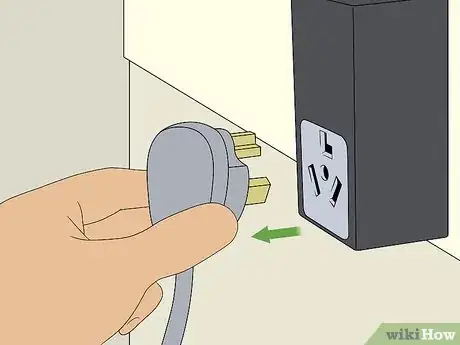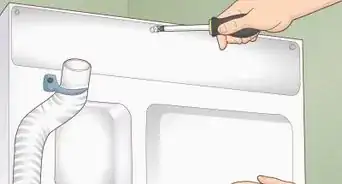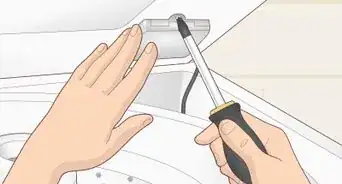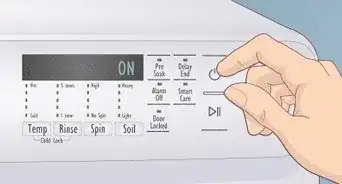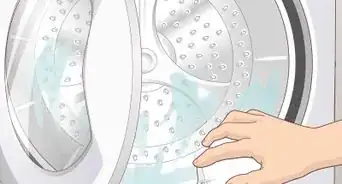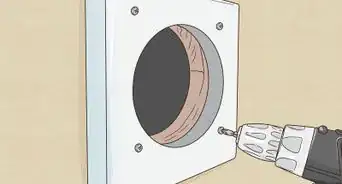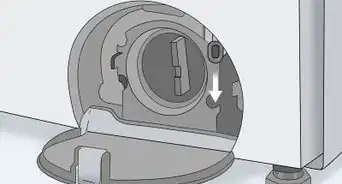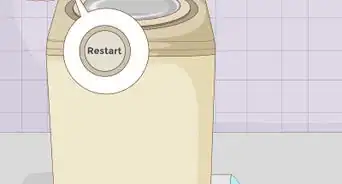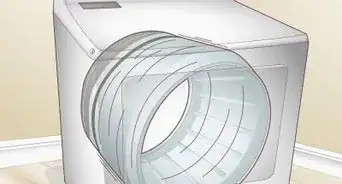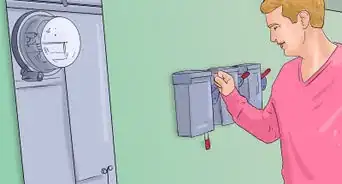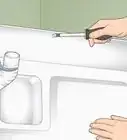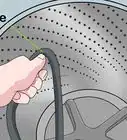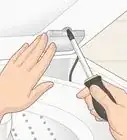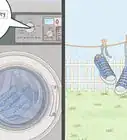This article was co-authored by Allen Lee. Allen Lee is a Home Improvement Specialist and the Owner of Honest Lee Handyman Services, a licensed and insured handyman business servicing Sacramento, California, and surrounding areas. Working with homeowners and businesses to get their small repairs done in a timely and efficient manner, Honest Lee Handyman Services provides gutter and dryer vent cleaning along with fixture, fence, drywall, and toilet repairs.
There are 7 references cited in this article, which can be found at the bottom of the page.
This article has been viewed 352,712 times.
A burning smell coming from your dryer is not a good sign—it’s a fire hazard. Try removing any built up lint from the lint catcher, cleaning the inside of the dryer, and/or cleaning the hose duct and vents. If the smell persists, you may need to check the electrical components inside the dryer and have them replaced. Stop using the dryer immediately and, if necessary, call an electrician to fix it.
Steps
Removing Lint Buildup
-
1Remove any lint from the lint catcher. This is the small mesh screen that pulls in and out of the dryer. For forward-facing dryers, it can be located on the front of the loading panel. For top-load dryers, it may be located under a small flap.[1]
- Clean the lint catcher after each load to avoid lint buildup and, consequently, a fire hazard.
-
2Unplug the power cord from the wall. Disconnecting the power is a necessary safety precaution before messing with any parts of your dryer. If you have a gas dryer, turn the gas valve on the dryer line or turn the valve supplying gas to your whole house. Then unscrew the flex hose to disconnect the dryer from the gas line and use a gas line cap to seal the line until you’re done cleaning the dryer.[2]
- If you’re not sure whether your dryer is gas or electric, refer to the manual or look up the manufacturer and model number online for more information.
- Some dryer manuals will also give you specific cleaning instructions.
Advertisement -
3Use a screwdriver to remove the top panel of your dryer. Lint can build up in the screen (especially if you don’t clean it after each load), falling down into the shaft that holds the lint catcher. Removing the top panel will allow you to clean any lint that may have fallen beyond the lint trap. First you’ll need to take out the screws located around the opening of the lint trap. Then pull the entire top panel towards you and lift it up to release the metal catches.[3]
- If your dryer faces forward, the metal catches are typically located about 3 inches (7.6 cm) to 4 inches (10 cm) down from the top and up from the floor. You’ll have to slide the panel upwards or downwards depending on how your dryer is assembled.
- If your dryer has a condenser unit that holds the lint trap, remove it from the dryer and rinse away any lint under the faucet of a large sink. Make sure to rinse both sides of the unit and let it air dry for a few hours before inserting it back into the dryer.
- You may need to wedge a screwdriver between the top or front panel and the base of the dryer to pry it open.
-
4Use a dryer brush to remove lint from the lint filter opening. Depending on your dryer, the lint filter opening will look like a rectangular tray (this is where the lint catcher slides in and out) or a deep crevice (for front loading machines). Stick a dryer cleaning brush down into it and twist it around, moving it back and forth to get all of the lint out.[4]
- You can purchase a dryer lint cleaning kit at any hardware store.
- If you don’t have a lint cleaning brush, you can use a large pipe brush cleaner or a vacuum with a hose attachment that’s small enough to fit inside the opening.
Note: Avoid trying to put your hands down into the lint filter opening. Often times, the opening is not wide enough (and a brush will collect more lint anyway).
-
5Replace the lint trap, the lint panel, and plug in the dryer to test it. After cleaning the most common places for lint to accumulate, replace all the parts and reconnect the dryer to the power source. If your dryer is gas-powered, reconnect the gas line and turn it on. Run the dryer for up to 1 or 2 minutes to see if the burning smell is gone.[5]
- If there’s no smell you can use your dryer as usual—just remember to clean out the lint trap after each load.
- If the burning smell persists, there may be lint stuck around the parts inside of the dryer.
Vacuuming the Inside of the Dryer
-
1Unplug the power cord and disconnect the gas, if applicable. You’ll need to shut off the power and gas to stay safe before opening up the body of your dryer. If your dryer is gas-powered, turn the gas valve on the dryer line to the “off” position or turn off the valve supplying gas to your whole house. Then unscrew the flex hose to disconnect the dryer from the gas line and use a gas line cap to seal the line.[6]
- Refer to the manual that came with your electric or gas dryer if you’re not sure where to locate the power cord or gas line.
-
2Use a screwdriver to wedge open and remove the bottom panel. Insert a screwdriver into the gaps close to the where the catches are (usually at the top corners of the panel). You may need to slide the screwdriver to the left or right and wiggle it around until the catches release.[7]
- Refer to your dryer’s manual to see exactly where the catches are and if there are any additional instructions about how to remove the panel.
- If your dryer doesn’t have a removable panel underneath where you load clothes, you may need to slide it away from the wall and remove the back panel.
-
3Use a vacuum’s hose attachment to suck out any lint buildup. Sometimes lint can drop into the body of the dryer, coming in contact with the heating element and causing the lint to heat up (hence the burning smell). Use a vacuum attachment to clean out all the lint.[8]
Tip: Go slowly and be careful vacuuming around wires and small parts.
-
4Reattach both panels, replace the lint screen, and test the dryer. Reattach the bottom and top panels, sliding and pushing them into the correct position until you hear the catchers click into place. Then replace the screws on the lint trap opening before plugging in the dryer. Run it for about 1 or 2 minutes and if you still notice the burning smell, stop it immediately and unplug it again.
- If the smell persists, you may need to clean the hose duct or call a professional.
Cleaning the Hose and Vent
-
1Unplug the power cord from the wall for safety purposes. Make sure there is no electrical current running to your dryer before you handle any parts of it. If your dryer is gas-powered, you should also turn off the gas. Turn the valve connecting your dryer to the gas line to the off position or shut off the main valve that supplies gas to your entire house.[9]
- Unscrew the flex hose to disconnect the dryer from the gas line and use a gas line cap to seal the line until you’re done cleaning the dryer.
- Failing to disconnect the power can result in moderate shocks to electrocution, so be sure to disconnect it!
-
2Slide the dryer away from the wall to access the exhaust hose. Slowly pull the dryer away from the wall so you can access the venting hose, the flexible tube connected to the back of your dryer.[10]
- Depending on your model, the hose may look shiny and silvery or like white corrugated plastic.
-
3Use a screwdriver to unscrew the clamps that hold the hose in place. Loosen and unscrew the clamps that keep the hose attached to the dryer and the wall. Detach each end of the hose and pull out as much lint as you can with your hand. Use a vacuum with a long wand attachment to clean deeper into the tube.[11]
- Inspect and clean out the hose and the vent at least every 6 months or so, because lint buildup is a fire hazard.
- Look at both ends of the hose to check for any kinks—these small depressions can reduce airflow and allow bits of lint to get into the central dryer cabinet.
- Dryer repair companies can also clean this for you if you don’t want to do it yourself.
-
4Use a dryer vent cleaning brush to clean out lint from the vent. The vent is where the hose attaches to the wall. It’s easy for lint to get trapped in the vent. Get a dryer vent cleaning brush kit that you can get from a local hardware store, and run it from the bottom and from the top. Use a cleaning brush with a long stick attachment to pull out lint, making sure to clean as far into the vent as you can.[12]
- A useful trick: you can put a flashlight inside the dryer ducting that goes up through the roof, turn you phone on selfie mode, and then put it in the ducting. This way you can see up the ducting and check how serious the clog looks.
- If you have a really bad clog, you can hook a shop vacuum to the bottom of the dryer vent and suck out the lint as it gets dislodged from the vent.
Tip: Some dryer cleaning kits come with detachable scrub heads and 2 feet (0.61 m) long stick attachments. You can fit these together to make a 4 feet (1.2 m) or 6 feet (1.8 m) cleaning tool to go deeper into the vent if necessary.
Inspecting Internal Parts
-
1Use a multimeter to see if you need a new thermostat. The thermostat monitors the internal temperature of the dryer and shuts it off if it gets too hot. If your thermostat is broken, the burning smell could be due to overheating. Unplug the machine, remove the back panel of the dryer, and remove the small cylindrical or rectangular-shaped thermostat by disconnecting the wires from both sides. Then set your multimeter to the lowest ohm reading (RX1) and place the two probes of the meter to the terminals (on one each, it doesn’t matter which color probe goes on which side).[13]
- The terminals are the two metal prongs on either side of the thermostat.
- Before disconnecting the thermostat wires, take a photo to keep track of which wires go where or jot it down on a notepad.
- At room temperature, the multimeter should have a reading of zero. If it reads infinity, get it replaced.
-
2Inspect the heating element in electrical dryers for signs of breakage or burning. The heating element looks like a coil (made of nickel and chrome) or series of interconnected coils housed inside a small open-faced box. Unplug the machine and remove the back panel in order to access it. Take it out by unscrewing the sensors located at the top and bottom of the vessel and unhooking the 2 wires located below the bottom screw.
- Be sure to inspect each coil. If you see any dark spots (blackening) or broken coils, call a repair service to replace the element.
- If two adjacent coils are touching (as if they’ve been smashed together like a slinky), it could cause an electrical short and needs to be replaced.
- You can also use a multimeter to test for proper functioning. Set the multimeter to the continuity setting and press the probes onto the wire terminals (one on each terminal) located at the outside corner of the encasing. If the multimeter beeps, the element is still good. If it makes no sound, the element needs to be replaced.[14]
-
3Inspect the wires attached to the heating element in a gas dryer. If you have a gas dryer, the heating element is located inside the electrical cabinet on the backside of the dryer. Look for a long white or silver cylindrical tube (the combustion tube) with two or three wires attached. If the wires or old or have come unattached, they may have partially melted and caused the burning smell.[15]
Note: If you see any signs of burning or melting on any of the wires, call a professional to have them replaced.
-
4Call a professional to replace the belt if you see physical slack or damage. The belt loops around the drum, under the pulley, and around the motor pulley. A worn out belt might loosen, causing slippage, friction, and heat (hence the burning smell). Unplug the dryer, slide it away from the wall, and remove the back panel to access the belt. It should be tightly wound around something that looks like a pulley system.[16]
- In some models, the belt and motor pulley are located toward the front of the machine. If this is the case, remove the front panel in order to access and inspect the belt.
- Use your hand to tug on the belt, making sure it remains taught. If you notice any slack, parts that appear melted, or sections that have been rubbed away (revealing the internal fibers), call a professional to replace it.
- Be careful when inserting your hand into the body of the dryer, the edges of the cabinets and internal casings are sharp!
- Depending on the make and model of your dryer, the belt will be located either behind the back panel or behind the front bottom panel.
Community Q&A
-
QuestionJust replaced the Heating element on a Whirlpool Duet dryer. I started up the dryer for 30 seconds and got a burning smell. It's possible that I stirred up lint, but I'm concerned about wiring problems?
 Community AnswerIt either works or it doesn't as far as wiring problems go. If the smell hasn't gone away by now (break-in of the new element), then call in an appliance repairman.
Community AnswerIt either works or it doesn't as far as wiring problems go. If the smell hasn't gone away by now (break-in of the new element), then call in an appliance repairman. -
QuestionAfter cleaning all the lint from the heating element, what else could be the problem if it still smells burnt?
 Community AnswerClean everything else, most especially the vent hose or tube. If that doesn't do it, then you need to call in an appliance repairer to address the problem.
Community AnswerClean everything else, most especially the vent hose or tube. If that doesn't do it, then you need to call in an appliance repairer to address the problem. -
QuestionI had a belt that got twisted and burned up and broken in the dryer. I replaced the belt, but I cannot get the burnt smell out of the dryer so my cloths smell burnt when I dry them. Is there away to remove the burnt smell?
 Community AnswerAssuming the belt left some form of remains stuck to the inside of the dryer, you should do your best to scrub it off. You can use a strong deodorant or spray inside the dryer as well (one that doesn't burn and can work in high-temperature conditions). If there are no remains, then the burnt-smelling gas particles might simply need to be fanned out. You can leave the dryer open to air out the smell or use a fan.
Community AnswerAssuming the belt left some form of remains stuck to the inside of the dryer, you should do your best to scrub it off. You can use a strong deodorant or spray inside the dryer as well (one that doesn't burn and can work in high-temperature conditions). If there are no remains, then the burnt-smelling gas particles might simply need to be fanned out. You can leave the dryer open to air out the smell or use a fan.
Warnings
- Always unplug the dryer before cleaning it.⧼thumbs_response⧽
- If the burning smell persists, you may have an electrical issue inside the dryer. Do not use the dryer and call a professional repair service.⧼thumbs_response⧽
Things You’ll Need
Removing Lint Buildup
- Screwdriver
- Dryer lint cleaning brush
- Vacuum (with hose attachment)
- Dryer lint cleaning kit (optional)
Cleaning the Venting Hose and Duct
- Screwdriver
- Vacuum (with hose attachment)
- Dryer lint cleaning kit (optional)
Inspecting Electrical Parts
- Multimeter (for thermostat and element inspection)
- Screwdriver (for thermostat and belt inspection)
References
- ↑ https://www.familyhandyman.com/appliance-repair/washer-and-dryer-repair/dryer-lint-cleaning-tips/
- ↑ https://www.familyhandyman.com/appliance-repair/washer-and-dryer-repair/dryer-lint-cleaning-tips/
- ↑ https://www.familyhandyman.com/appliance-repair/washer-and-dryer-repair/dryer-lint-cleaning-tips/
- ↑ https://www.familyhandyman.com/appliance-repair/washer-and-dryer-repair/dryer-lint-cleaning-tips/
- ↑ https://www.familyhandyman.com/appliance-repair/washer-and-dryer-repair/dryer-lint-cleaning-tips/
- ↑ https://www.familyhandyman.com/appliance-repair/washer-and-dryer-repair/dryer-lint-cleaning-tips/
- ↑ https://www.familyhandyman.com/appliance-repair/washer-and-dryer-repair/dryer-lint-cleaning-tips/
- ↑ https://www.familyhandyman.com/appliance-repair/washer-and-dryer-repair/dryer-lint-cleaning-tips/
- ↑ https://www.bobvila.com/articles/burning-smell-from-dryer/
- ↑ https://www.bobvila.com/articles/burning-smell-from-dryer/
- ↑ https://www.bobvila.com/articles/how-to-clean-a-dryer-vent/
- ↑ https://www.cnet.com/how-to/how-to-clean-your-dryer-duct-in-5-steps/
- ↑ https://www.partselect.com/Dryer+test-thermostat+repair.htm
- ↑ https://youtu.be/8AG7PtCy0v4?t=82
- ↑ https://youtu.be/8BZE9yYMaWk?t=13
- ↑ https://www.bobvila.com/articles/burning-smell-from-dryer/
About This Article
If you need to troubleshoot a dryer that smells like it is burning, start by removing any lint from the lint catcher. Next, unplug the dryer from the wall, use a screwdriver to remove the lint panel, and clean out any lint that has fallen into the shaft beneath it with a dryer brush. Then, use a screwdriver to wedge open and remove the bottom panel of the dryer and use your vacuum’s hose attachment to suck up any lint buildup there. Go slowly and be careful vacuuming around wires and small parts! Finally, reattach both panels, replace the lint screen, and test the dryer. For tips on cleaning out the hose and vent if the burning smell persists, read on!









